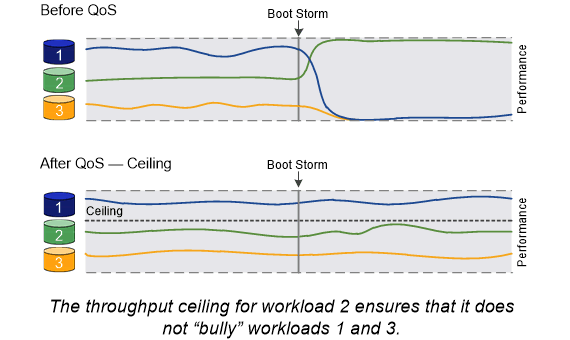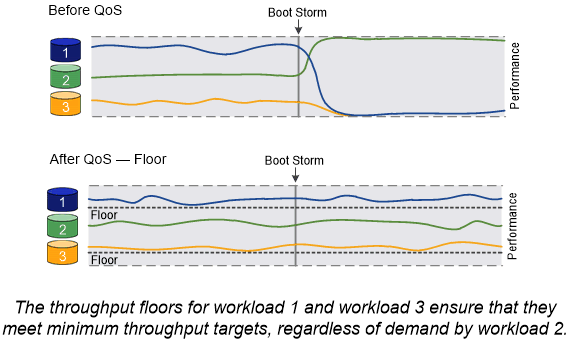Load balancing in ONTAP
 Suggest changes
Suggest changes


Performance of workloads begins to be affected by latency when the amount of work on a node exceeds the available resources. You can manage an overloaded node by increasing the available resources (upgrading disks or CPU), or by reducing load (moving volumes or LUNs to different nodes as needed).
You can also use ONTAP storage quality of service (QoS) to guarantee that performance of critical workloads isn't degraded by competing workloads:
-
You can set a QoS throughput ceiling on a competing workload to limit its impact on system resources (QoS Max).
-
You can set a QoS throughput floor for a critical workload, ensuring that it meets minimum throughput targets regardless of demand by competing workloads (QoS Min).
-
You can set a QoS ceiling and floor for the same workload.
Throughput ceilings
A throughput ceiling limits throughput for a workload to a maximum number of IOPS or MB/s. In the figure below, the throughput ceiling for workload 2 ensures that it does not “bully” workloads 1 and 3.
A policy group defines the throughput ceiling for one or more workloads. A workload represents the I/O operations for a storage object: a volume, file, or LUN, or all the volumes, files, or LUNs in an SVM. You can specify the ceiling when you create the policy group, or you can wait until after you monitor workloads to specify it.

|
Throughput to workloads might exceed the specified ceiling by up to 10 percent, especially if a workload experiences rapid changes in throughput. The ceiling might be exceeded by up to 50% to handle bursts. |

Throughput floors
A throughput floor guarantees that throughput for a workload does not fall below a minimum number of IOPS. In the figure below, the throughput floors for workload 1 and workload 3 ensure that they meet minimum throughput targets, regardless of demand by workload 2.

|
As the examples suggest, a throughput ceiling throttles throughput directly. A throughput floor throttles throughput indirectly, by giving priority to the workloads for which the floor has been set. |
A workload represents the I/O operations for a volume, LUN, or, beginning with ONTAP 9.3, file. A policy group that defines a throughput floor cannot be applied to an SVM. You can specify the floor when you create the policy group, or you can wait until after you monitor workloads to specify it.

|
Throughput to a workload might fall below the specified floor if there is insufficient performance capacity (headroom) on the node or aggregate, or during critical operations like |

Adaptive QoS
Ordinarily, the value of the policy group you assign to a storage object is fixed. You need to change the value manually when the size of the storage object changes. An increase in the amount of space used on a volume, for example, usually requires a corresponding increase in the throughput ceiling specified for the volume.
Adaptive QoS automatically scales the policy group value to workload size, maintaining the ratio of IOPS to TBs|GBs as the size of the workload changes. That's a significant advantage when you are managing hundreds or thousands of workloads in a large deployment.
You typically use adaptive QoS to adjust throughput ceilings, but you can also use it to manage throughput floors (when workload size increases). Workload size is expressed as either the allocated space for the storage object or the space used by the storage object.

|
Used space is available for throughput floors in ONTAP 9.5 and later. It isn't supported for throughput floors in ONTAP 9.4 and earlier. |
+ Beginning with ONTAP 9.13.1, you can use adaptive QoS to set throughput floors and ceilings at the SVM level.
-
An allocated space policy maintains the IOPS/TB|GB ratio according to the nominal size of the storage object. If the ratio is 100 IOPS/GB, a 150 GB volume will have a throughput ceiling of 15,000 IOPS for as long as the volume remains that size. If the volume is resized to 300 GB, adaptive QoS adjusts the throughput ceiling to 30,000 IOPS.
-
A used space policy (the default) maintains the IOPS/TB|GB ratio according to the amount of actual data stored before storage efficiencies. If the ratio is 100 IOPS/GB, a 150 GB volume that has 100 GB of data stored would have a throughput ceiling of 10,000 IOPS. As the amount of used space changes, adaptive QoS adjusts the throughput ceiling according to the ratio.


